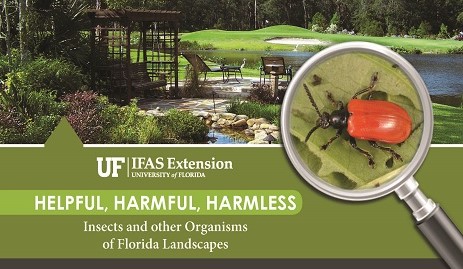
by Danielle S. Williams | Mar 13, 2025
When most people think of insects, they think of the bad ones, but not all insects are bad! Insects are labeled as bad or ‘pests’ when they start causing harm to people or the things we care about such as plants, animals, and buildings but most insects are GOOD! In fact, of the millions of insect species found throughout the world, less than 2% are actually considered pests. There are several different ways insects can be beneficial in your garden or landscape:
- They prey on pest insects. Many species of insects eat pest insects! For example, lady beetles (ladybugs) and lacewings eat pest insects like aphids, mealybugs and whiteflies. They can help keep insect populations in balance. It’s important to recognize some of the beneficial insect species (and their different life cycle stages) that you might find in your garden. The UF/IFAS Extension bookstore has a great identification guide: Helpful, Harmful, Harmless?

- They parasitize pest insects. Some species of good insects live in or on pest insects. For example, parasitoid wasps lay their eggs into pest insects and when the wasp eggs hatch, they feed on the pest species. Here’s a really great video to show the process: Parasitic Wasps – National Geographic
- They pollinate. Many of the good insects like native bees, honeybees, butterflies and moths help us pollinate our gardens. They transfer pollen grains from flower to flower that help plants bear fruit.
- They decompose. Insects also help aerate our soils by breaking down dead material and recycling nutrients. Dung beetles are a great example! They bury and consume dung which improves soil quality.
One of the best things you can do for your garden is learn to differentiate pest insect species from beneficial ones! Just because you see an insect on your plant, doesn’t necessarily mean it is causing harm. If you see an insect, are you seeing injury to the plant? If so, what type of injury (defoliation, yellowing, leaf curling)? If you aren’t seeing injury, then you may not have anything to worry about. If you find something you’re unsure of, you can always reach out to your local UF/IFAS Extension Agent!
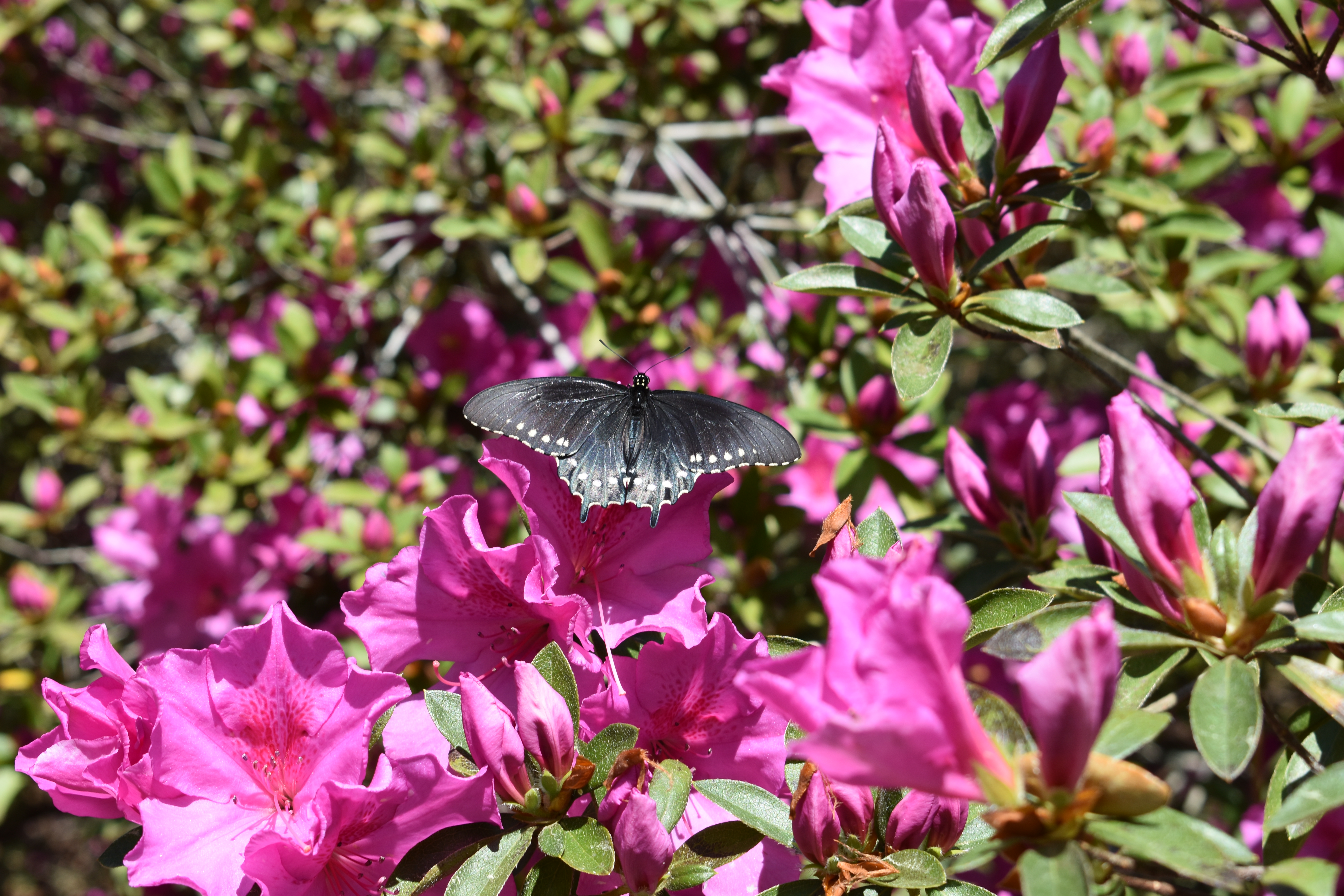
Pipevine swallowtail on Azalea.
Attracting and encouraging beneficial insects can really help your garden and landscape thrive. The best way to attract beneficial insects to your garden or landscape is to have lots of plant diversity. A mix of trees, shrubs, annual and perennial flowers in the landscape is best. Trees and shrubs will provide shelter for insects to overwinter, and flowers provide pollen and nectar.
Flowers in the carrot family (Apiaceae) such as caraway, coriander, cilantro, dill and fennel are attractive for parasitic wasps. Flowers in the Aster family (Asteraceae) such as blanketflower, coneflower, coreopsis, cosmos and goldenrod are attractive for larger predators like lady beetles and soldier beetles. These can be incorporated into the garden or flower beds.
For more information on attracting beneficial insects to your landscape, contact your local UF/IFAS Extension Agent!

by Matt Lollar | Mar 13, 2025
Attracting wildlife is one of the Florida Friendly Landscaping principles. However, some species are better observed from long distance. Deer are beautiful creatures and taste pretty good too, but they can wreak havoc to a landscape and to fruits and vegetables. There are a number of methods to deter deer, but you’ll need to keep them guessing to limit damage to your yard.
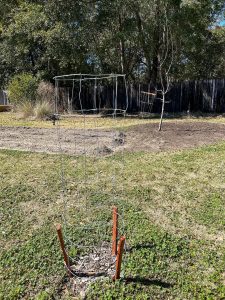
A plant cage formed from metal fencing. Photo Credit: Matt Lollar, UF/IFAS Extension – Santa Rosa County
Physical Barriers – This deterrent method may be the most effective if installed correctly, but it can also be costly and requires the most labor and engineering to install.
- Temporary Deer Fencing – Plastic mesh fencing can temporarily keep deer away from plantings. This material can be draped over plants or attached to posts or fencing with plastic ties or wire.
- Hardware Cloth and Seedling Tubing – Hardware cloth can be formed into different shapes or secured to small structures to form a barrier around small plants. UV-inhibited polyethylene and polypropylene mesh seedling tubes can be bent into cylinders and placed around young shrubs and trees to protect them from foraging deer and other wildlife.
- Garden Fencing – There are a variety of gauges available for this fencing. Heavier gauges are recommended to help keep deer out. It’s important to note that most adult deer can jump 7 feet high, so a fence height of at least 8 feet is recommended.
- Electric Fencing – Peanut butter can be spread on a single strand of electric wire to encourage deer to check it out. More permanent electric fences can be installed, but are significantly more expensive.
Scare Items – Deer are skittish to things that are unfamiliar to them. However, it doesn’t take them long to adapt.
- Ribbons and Tape – Light-weight ribbons and tape fluttering in the wind can help deter deer. Holographic and iridescent foil materials have shown the best results because they reflect sunlight and create more noise in the wind.
- Motion Activated Sprinklers – Hitting a deer directly and the sound of water being turned on are deterrents for deer and other wildlife. It is best to periodically move the location of these sprinklers to improve their effectiveness.
- Noisemakers – Whistles, firecrackers, and propane cannons can annoy deer, and people too. Unfortunately, deer become accustomed to these tactics. It is best to use noisemakers in combination with other deterrent methods.
- Dogs – Just having a dog around can help keep deer away. Even if it’s a dog that has no care to bark at or chase a deer, its scent alone may be enough to deter them.
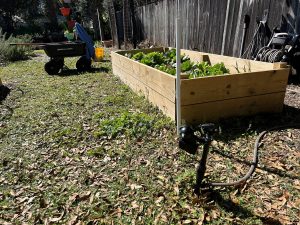
A motion activated sprinkler used to deter wildlife from a raised bed garden. Photo Credit: Matt Lollar, UF/IFAS Extension – Santa Rosa County
Chemical Repellents – A plethora of chemicals are marketed as deer deterrents. These products can work as odors, create bad tastes, or incite fear. Common ingredients include capsaicin, predator urine, egg solids, garlic, and soap. A number of factors can contribute to the effectiveness of chemical repellents including the growth stage of the plants to be protected and frequency of reapplication,
Resistant Plants – Deer eat almost anything. They sometimes even eat so-called “deer resistant plants”. However, the plants listed below are less desirable to deer. For a more comprehensive list of plant susceptibility to deer damage please visit the archived publication “Ornamental plant susceptibility to damage by deer in Florida”.
- Trees – Deer will rub on almost any tree, but a few they are less likely to eat include: bottlebrush, sabal palm, crape myrtle, edible fig, loquat, live oak, magnolia, and yaupon holly.
- Shrubs – Some shrubs that deer are less likely to eat include: mahonia, viburnum, wax myrtle, juniper, and most evergreen azaleas.
- Annuals and Perennials – There are quite a few annuals and perennials that have shown signs of resistance to deer including: black-eyed Susan, bush daisy, cone flower, dusty miller, marigold, and salvia.
More detailed information on wildlife deterrents can be found in the publication “How to Use Deterrents to Stop Damage Caused by Nuisance Wildlife in Your Yard”.
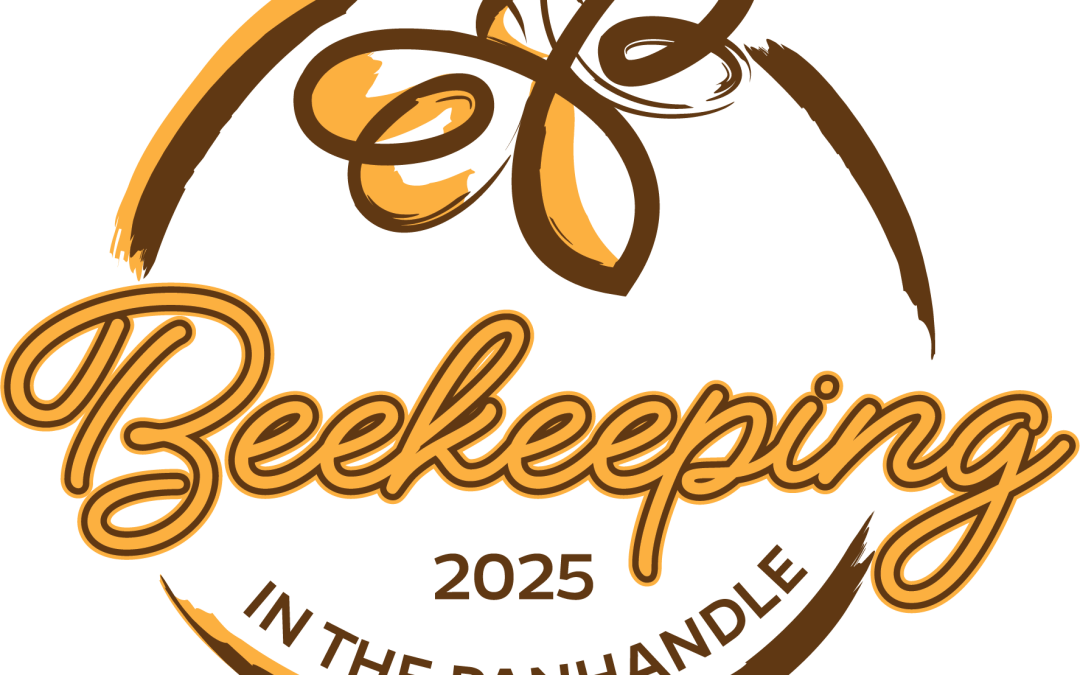
by Julie McConnell | Mar 6, 2025
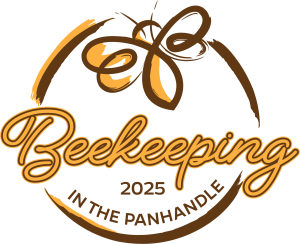
Are you an experienced beekeeper looking to expand your education?
Are you a new beekeeper or maybe just considering jumping into honey bees?
Do you want to see hands-on demonstrations with live honey bees?
If you can answer yes to of the questions above, you don’t want to miss the 2025 Beekeeping in the Panhandle Conference April 4-5, 2025, at the Washington County Agriculture Center (1424 Jackson Ave, Chipley, FL 32428)!
UF/IFAS Extension Washington County and the Central Panhandle Beekeepers Association have lined up some top-notch speakers and will ensure there are educational opportunities for all skill levels at this two-day event. Speakers will be joining us from the UF/IFAS Honey Bee Research and Extension Lab, Florida Department of Agriculture and Consumer Services, and beekeepers with experience managing honey bees in this region.
Sample Topics include:
- Honey Bee Biology
- Hive Components
- Top Tips for Beekeepers
- Making Splits
- Integrated Pest Management in a Honey Bee Colony
- Seasonal Efficacy of Varroa Treatments
- What you Need to Know About the Yellow-legged Hornet (Vespa velutina)
- Pesticide Risk Assessment in Honey Bees
- Pollinator Plants
- Product Making Demonstrations
- Apiary Demonstrations
Early bird registration is open through 4:59 p.m. on March 17, 2025, so get your tickets now for the best value!
The University of Florida is committed to providing universal access to all of our events. To arrange disability accommodations, please contact Julie McConnell (juliebmcconnell@ufl.edu ) or call 850-638-6180 at least 2 weeks in advance. We are proud to be an Equal Opportunity Institution.
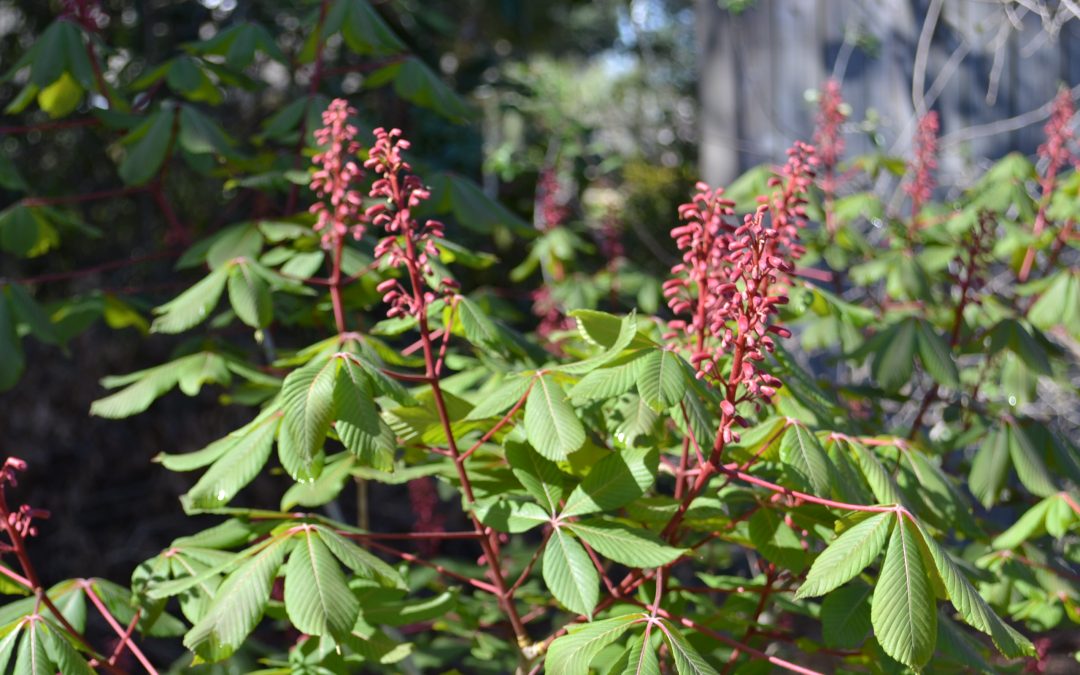
by Beth Bolles | Mar 6, 2025
One plant that signals our change in season is beginning to bloom in natural areas and woodland gardens. The Red buckeye, Aesculus pavia, is forming large spikes of red flowers and the attractive palmate leaves are unfurling.
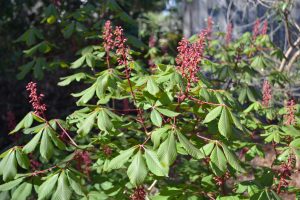
Red buckeye in the late winter sunshine. Photo by Beth Bolles UF IFAS Extension Escambia County.
If you enjoy a more natural landscape, Red buckeye is a perfect fit. It often has open growth with multiple branching stems which give it more of a shrub look in many landscapes. Plant size can vary from 8-15 feet. The blooms are beautiful and the tubular flowers can be visited by overwintering or returning hummingbirds.
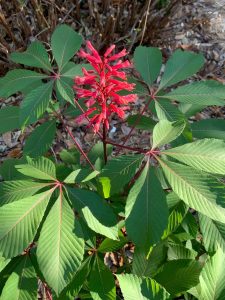
Single bloom with palmate leaves. Photo by Beth Bolles UF IFAS Extension Escambia County
Although plants can tolerate full sun, plants look their best with some afternoon shade as the summer progresses. A high canopy that allows filtered sun would be excellent throughout our summer weather. Choose a location with moist, well drained soils. In general, plants will drop leaves earlier than other deciduous plants in your landscape so make sure your location is a spot to show off the late winter/early spring blooms.
A precaution with the Red buckeye is that the fruit is toxic for people and pets. The large capsules will contain several seeds which can drop and grow new plants. Squirrels will also enjoy the seeds.
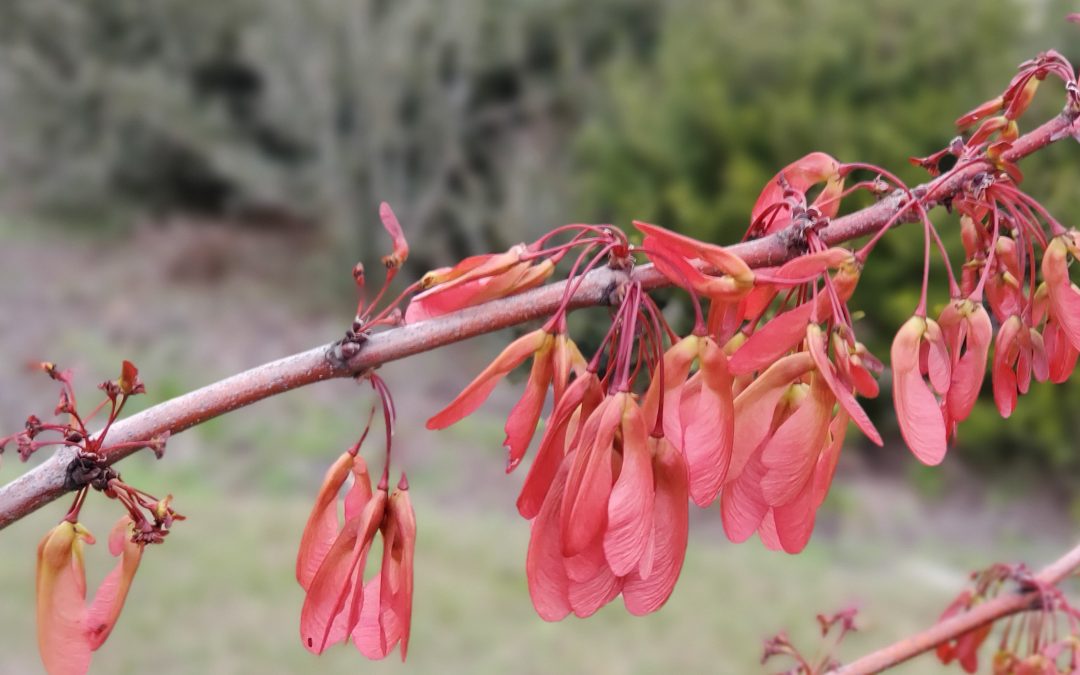
by Daniel J. Leonard | Mar 6, 2025
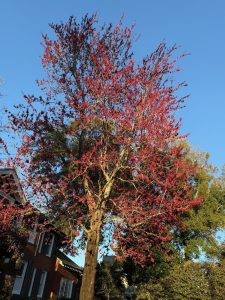
Red Maple in flower. Photo courtesy of Carrie Stevenson.
A month ago, when the Panhandle was covered in snow, it would have been hard to imagine that spring was just around the corner. But warm spring weather has arrived, and with it, the first of our native trees to bloom each year – the venerable Red Maple (Acer rubrum). Reliably heralding spring in Northwest Florida each February, Red Maples adorn our roadsides and low-lying natural areas with brilliant red blooms. Spotting a Red Maple blooming amongst the otherwise drab landscape means winter is on its way out and spring has sprung – or will shortly.
Beyond the blooms, Red Maple has much to offer as a landscape tree. For one, it is unbelievably adaptable. Across its native range – one of the most expansive of any species in the US, occurring naturally from Maine all the way down to the Everglades,* the tree can handle soils that range from periodically inundated along streams and other wet areas to more well-drained upland sites. Adding to its adaptability, in the Panhandle, Red Maple typically tops out around 40’ in height and around 20’ wide with a spreading vase shape, rarely growing out of scale with most landscapes.
*Since Red Maple occurs over a huge area of the US, it’s important to purchase seedlings or named varieties that hail from areas with like climate conditions to the Panhandle. Avoid varieties from northern states for best performance.
Red Maple is one of the few shade trees that has true four-season interest in our area. We’ve already talked about its spring flowers, but it also has attractive deep green foliage in the summer (some selections, like ‘Summer Red’ are even known for reddish purple new growth), famous fall color (though it is more muted in Florida than locales farther north), and unique ridged light gray bark in the winter. The seeds of Red Maple are even pretty. These two-winged seed structures, called a samara, follow the spring flower show, appear pinkish red, and are a favorite of squirrels and other critters.
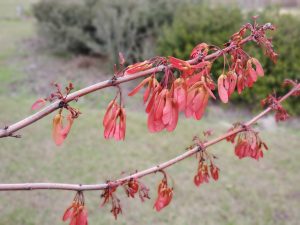
Red Maple samaras. Photo courtesy of Daniel Leonard.
Red Maple is a quick growing, low maintenance tree as well. If planted correctly and properly cared for, the species can grow several feet per year in its youth. Site the tree in a moist site that receives full sun, plant slightly higher than the soil level of the container the tree was purchased in to compensate for soil settling post-planting, and water regularly until established. After establishment, periodic fertilizing with a balanced fertilizer will help ensure Red Maple’s nutritional needs are met and maximum growth achieved.
If you’ve been looking for a medium-sized, native, flowering shade tree with four-season interest, Red Maple may be just the tree for your landscape. Plant one today! For more information on Red Maple, other recommended landscape plants, or any other horticultural topic, contact your local UF/IFAS Extension office.













